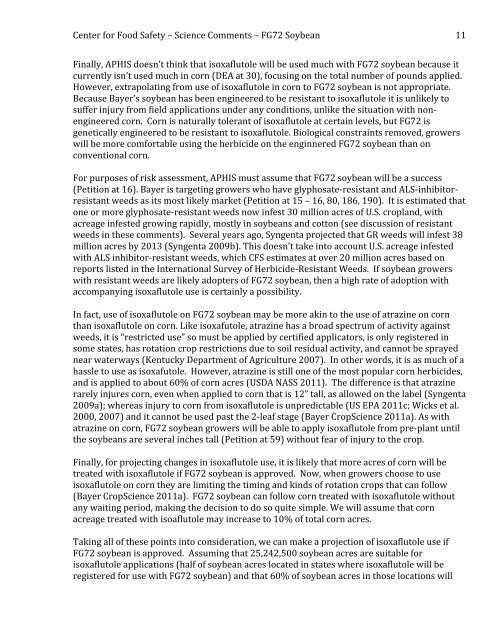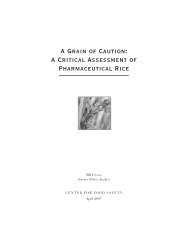a four-fold rise - Center for Food Safety
a four-fold rise - Center for Food Safety
a four-fold rise - Center for Food Safety
Create successful ePaper yourself
Turn your PDF publications into a flip-book with our unique Google optimized e-Paper software.
<strong>Center</strong> <strong>for</strong> <strong>Food</strong> <strong>Safety</strong> – Science Comments – FG72 Soybean <br />
11 <br />
Finally, APHIS doesn’t think that isoxaflutole will be used much with FG72 soybean because it <br />
currently isn’t used much in corn (DEA at 30), focusing on the total number of pounds applied. <br />
However, extrapolating from use of isoxaflutole in corn to FG72 soybean is not appropriate. <br />
Because Bayer’s soybean has been engineered to be resistant to isoxaflutole it is unlikely to <br />
suffer injury from field applications under any conditions, unlike the situation with non-engineered<br />
corn. Corn is naturally tolerant of isoxaflutole at certain levels, but FG72 is <br />
genetically engineered to be resistant to isoxaflutole. Biological constraints removed, growers <br />
will be more com<strong>for</strong>table using the herbicide on the enginnered FG72 soybean than on <br />
conventional corn. <br />
For purposes of risk assessment, APHIS must assume that FG72 soybean will be a success <br />
(Petition at 16). Bayer is targeting growers who have glyphosate-‐resistant and ALS-‐inhibitor-resistant<br />
weeds as its most likely market (Petition at 15 – 16, 80, 186, 190). It is estimated that <br />
one or more glyphosate-‐resistant weeds now infest 30 million acres of U.S. cropland, with <br />
acreage infested growing rapidly, mostly in soybeans and cotton (see discussion of resistant <br />
weeds in these comments). Several years ago, Syngenta projected that GR weeds will infest 38 <br />
million acres by 2013 (Syngenta 2009b). This doesn’t take into account U.S. acreage infested <br />
with ALS inhibitor-‐resistant weeds, which CFS estimates at over 20 million acres based on <br />
reports listed in the International Survey of Herbicide-‐Resistant Weeds. If soybean growers <br />
with resistant weeds are likely adopters of FG72 soybean, then a high rate of adoption with <br />
accompanying isoxaflutole use is certainly a possibility. <br />
In fact, use of isoxaflutole on FG72 soybean may be more akin to the use of atrazine on corn <br />
than isoxaflutole on corn. Like isoxafutole, atrazine has a broad spectrum of activity against <br />
weeds, it is “restricted use” so must be applied by certified applicators, is only registered in <br />
some states, has rotation crop restrictions due to soil residual activity, and cannot be sprayed <br />
near waterways (Kentucky Department of Agriculture 2007). In other words, it is as much of a <br />
hassle to use as isoxafutole. However, atrazine is still one of the most popular corn herbicides, <br />
and is applied to about 60% of corn acres (USDA NASS 2011). The difference is that atrazine <br />
rarely injures corn, even when applied to corn that is 12” tall, as allowed on the label (Syngenta <br />
2009a); whereas injury to corn from isoxaflutole is unpredictable (US EPA 2011c; Wicks et al. <br />
2000, 2007) and it cannot be used past the 2-‐leaf stage (Bayer CropScience 2011a). As with <br />
atrazine on corn, FG72 soybean growers will be able to apply isoxaflutole from pre-‐plant until <br />
the soybeans are several inches tall (Petition at 59) without fear of injury to the crop. <br />
Finally, <strong>for</strong> projecting changes in isoxaflutole use, it is likely that more acres of corn will be <br />
treated with isoxaflutole if FG72 soybean is approved. Now, when growers choose to use <br />
isoxaflutole on corn they are limiting the timing and kinds of rotation crops that can follow <br />
(Bayer CropScience 2011a). FG72 soybean can follow corn treated with isoxaflutole without <br />
any waiting period, making the decision to do so quite simple. We will assume that corn <br />
acreage treated with isoaflutole may increase to 10% of total corn acres. <br />
Taking all of these points into consideration, we can make a projection of isoxaflutole use if <br />
FG72 soybean is approved. Assuming that 25,242,500 soybean acres are suitable <strong>for</strong> <br />
isoxaflutole applications (half of soybean acres located in states where isoxaflutole will be <br />
registered <strong>for</strong> use with FG72 soybean) and that 60% of soybean acres in those locations will







